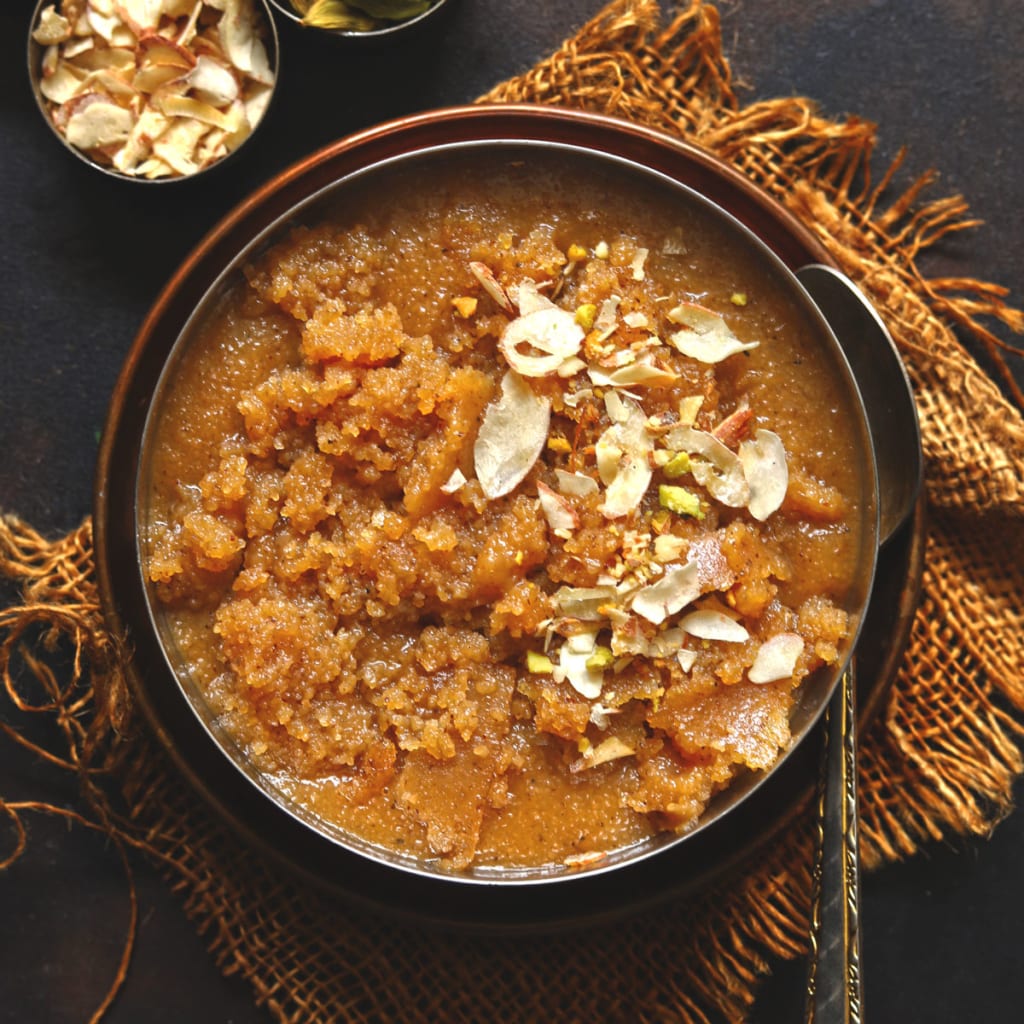
Start writing..Sooji halwa is a popular Indian dessert made from semolina, ghee, sugar and nuts. It is believed to have originated in the Indian subcontinent and is now enjoyed throughout the region, including in Pakistan, Nepal, and Bangladesh.
Halwa is a common dessert in the Middle East, Central Asia, and South Asia, with different variations available in different regions. However, the origins of sooji halwa are not clear, as it has been enjoyed in the Indian subcontinent for centuries.
The dessert is a popular offering to deities in temples and as prasad (offering) to devotees during Hindu festivals and puja. It is also served at weddings and other special occasions.
In earlier times, sooji halwa was not only enjoyed as a dessert but also served for breakfast or as a snack. It was considered to be a nutritious dish, as it was made from semolina, which is rich in carbohydrates and proteins, and fortified with ghee and nuts.
Today, sooji halwa is a beloved dessert and is often served alongside other classic Indian dishes such as biryani and curry. With its rich, nutty flavor and luxurious texture, it continues to be enjoyed across cultures and generations.I
ngredients:
- 1 cup fine semolina (sooji or rava)
- 1/2 cup ghee
- 1 cup sugar
- 2 cups water
- 1/4 tsp cardamom powder
- 1 tbsp sliced almonds
- 1 tbsp sliced pistachios
- 1 tbsp sliced cashews
Instructions:
1. In a heavy bottom pan, heat ghee on medium heat.
2. Add semolina to the ghee and roast it for 8-10 minutes or until it turns golden brown and fragrant.
3. In a separate pot, bring water and sugar to a boil.
4. Once the sugar has dissolved completely, reduce heat to low and let it simmer for 3-4 minutes.
5. Gradually add the sugar syrup to the roasted semolina while stirring constantly to avoid forming lumps.
6. Continue stirring until the mixture thickens and starts to come off the sides of the pan.
7. Add cardamom powder and mix well.
8. In a separate pan, roast the nuts for a few minutes until golden brown.
9. Add roasted nuts to the halwa (leaving some aside for garnish) and mix well.
10. Transfer the halwa to a serving dish and spread it evenly. Garnish with remaining nuts.
11. Serve hot or at room temperature.
Enjoy your delicious sujhi halwa!Sooji halwa is often made and served during auspicious periods or festivals in the Indian subcontinent. It is a customary dessert to offer to deities during worship or as prasad to devotees.
In Hinduism, it is believed that preparing and consuming food during auspicious occasions can bring positive energy and blessings to the home and family. Sooji halwa is considered a pure, Satvik food that can be offered to deities during puja or as prasad to devotees.
During Navratri, sooji halwa is often served as a dessert after fasting. It is also a popular dish served during Diwali, a festival of lights celebrated in India and around the world.
Furthermore, sooji halwa is also served during weddings, housewarming ceremonies, and other special occasions to bring prosperity and good fortune to the occasion.
Overall, sooji halwa is a beloved dessert enjoyed during auspicious periods or festivals in the Indian subcontinent. It is a symbol of purity, good fortune, and a way to bring positive energy into one's life.Halwa is a common sweet dish or Indian-style sweet pudding. It is widely made across the Indian subcontinent.
There are many variations of halwa – carrot halwa, atta (wheat) halwa, chikoo halwa, moong dal halwa, pineapple rava kesari, etc. Suji Ka Halwa is one of the easiest halwa recipes.The only secret mantra behind the triumphant bowl of sooji halwa is the slow roasting process of the semolina. The more semolina is slowly roasted, the better the flavor and color of the halwa.
Always use a heavy bottom pan to roast suji and make halwa. A nonstick pan or a lightweight pan is not an ideal choice.
About the Creator
Enjoyed the story? Support the Creator.
Subscribe for free to receive all their stories in your feed. You could also pledge your support or give them a one-off tip, letting them know you appreciate their work.





Comments
There are no comments for this story
Be the first to respond and start the conversation.